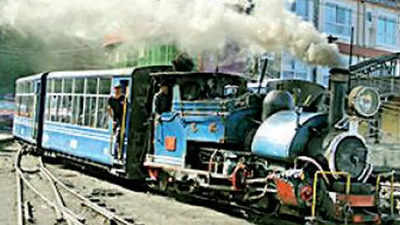- News
- City News
- kolkata News
- Darjeeling toy train logos registered, two decades after heritage tag
Trending
This story is from November 8, 2021
Darjeeling toy train logos registered, two decades after heritage tag
Indian Railways has registered the historic logos of the iconic “toy train” of Darjeeling Himalayan Railway (DHR) internationally as its intellectual property (IP), more than two decades after DHR was declared a World Heritage site by Unesco.

The toy train service was built between 1879 and 1881, and is about 88km long.
KOLKATA: Indian Railways has registered the historic logos of the iconic “toy train” of Darjeeling Himalayan Railway (DHR) internationally as its intellectual property (IP), more than two decades after DHR was declared a World Heritage site by Unesco.
While DHR plans to monetize the logos by using them on souvenirs, any use of the logo anywhere in the world would, from now on, require permission and the payment of a fee.
DHR was declared a World Heritage Site on December 5, 1999 by Unesco. The toy train service was built between 1879 and 1881, and is about 88km long. The long leisurely climb up snaking, picture-postcard mountain roads, from 328ft above sea level at New Jalpaiguri to about 7,218ft at Darjeeling, through Ghum, India’s highest railway station (7,407 ft) has been a must-do for tourists over the years who want to soak in the hills, minus the hurry of a daily commute.
And while the service has been modernised (six diesel locomotives handle most of the scheduled service), a large portion of the Raj-era’s quaint heritage has been preserved. The Red Panda service from Darjeeling to Kurseong, a short ride targeted at tourists, still uses vintage British-built B-Class steam locomotives, for instance.
Before applying for registering the logos, DHR worked hard to restore the original artwork on the walls of stations. “We mined archives to retrieve the oldest available artwork,” said DHR director A K Mishra, adding that some station buildings had the original logo intact. “Original documents and other items were retrieved. The logo is India’s national property. We need to protect it.”
The century-old logos — DHR has two — have a lot of history behind them and are popular across the world. They were randomly used by different agencies on merchandise, both at home and abroad. They were found used in Europe, particularly in the UK, and even in the US. Since they were not registered internationally, nothing could be done about such usage.
One of the two DHR logos is in bold black-and-white intertwined letters; the other, with a circular seal with a picture of mountains, forests and a river with “Darjeeling Himalayan Railway” written in white letters, is on a green background.
The Railway Board in Delhi and the DHR office in Kurseong initiated the process of registering the logo with the Controller General of Patents, Designs and Trademarks under the Union Ministry of Commerce and Industry in August. It was then sent to the World Intellectual Property Organization (WIPO), a specialized agency of the United Nations based in Geneva, Switzerland. The documentations were made in accordance with the procedure laid down in WIPO’s Vienna Classification. There is a six-month window for registering counter-claims, following which the Indian government’s claim will receive international approval.
While DHR plans to monetize the logos by using them on souvenirs, any use of the logo anywhere in the world would, from now on, require permission and the payment of a fee.
DHR was declared a World Heritage Site on December 5, 1999 by Unesco. The toy train service was built between 1879 and 1881, and is about 88km long. The long leisurely climb up snaking, picture-postcard mountain roads, from 328ft above sea level at New Jalpaiguri to about 7,218ft at Darjeeling, through Ghum, India’s highest railway station (7,407 ft) has been a must-do for tourists over the years who want to soak in the hills, minus the hurry of a daily commute.
And while the service has been modernised (six diesel locomotives handle most of the scheduled service), a large portion of the Raj-era’s quaint heritage has been preserved. The Red Panda service from Darjeeling to Kurseong, a short ride targeted at tourists, still uses vintage British-built B-Class steam locomotives, for instance.
DHR was recently picked up by the United Nations Postal Administration for making it part of the World Heritage Site stamp series.
Before applying for registering the logos, DHR worked hard to restore the original artwork on the walls of stations. “We mined archives to retrieve the oldest available artwork,” said DHR director A K Mishra, adding that some station buildings had the original logo intact. “Original documents and other items were retrieved. The logo is India’s national property. We need to protect it.”
The century-old logos — DHR has two — have a lot of history behind them and are popular across the world. They were randomly used by different agencies on merchandise, both at home and abroad. They were found used in Europe, particularly in the UK, and even in the US. Since they were not registered internationally, nothing could be done about such usage.
One of the two DHR logos is in bold black-and-white intertwined letters; the other, with a circular seal with a picture of mountains, forests and a river with “Darjeeling Himalayan Railway” written in white letters, is on a green background.
The Railway Board in Delhi and the DHR office in Kurseong initiated the process of registering the logo with the Controller General of Patents, Designs and Trademarks under the Union Ministry of Commerce and Industry in August. It was then sent to the World Intellectual Property Organization (WIPO), a specialized agency of the United Nations based in Geneva, Switzerland. The documentations were made in accordance with the procedure laid down in WIPO’s Vienna Classification. There is a six-month window for registering counter-claims, following which the Indian government’s claim will receive international approval.
End of Article
FOLLOW US ON SOCIAL MEDIA










